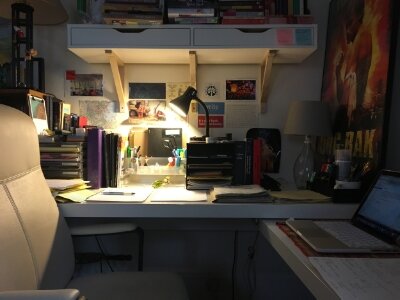How To Start Writing A Book
A couple months ago, a friend on Instagram asked me, How do you start writing a book?
This was a really good question, and I didn’t have an answer that I thought would be satisfactory. Usually, I would get an idea and start writing. Some scenes or passages would make sense or I’d find a way to string them together. Sometimes a story worked and sometimes it didn’t—but I would only find out when I finished writing. It took me four manuscripts to realize, Maybe this isn’t the most efficient way to go about my work.
I decided to save myself time, money, and heartache, and start pre-writing before actually sitting down to draft a manuscript. Learning how to prepare to write is its own skill, and following the advice of Ksenia Anske, Karah Rachelle, and Rachel Giesel, I found a method that works for me.
Initial Concept
It starts with an idea: a theme that I keep mulling over, a character that I’m curious about, an image that inspires me. Sometimes it’s just a feeling that I want to express. On her blog, Jane Friedman mentioned that part of a writer’s job is to know which ideas are worth pursuing. I’ve found the most worthwhile ideas intrigue me enough to start asking questions. Each time I come back to an idea, I’ll learn something new or make more connections. The idea starts to build into something more complex—the beginnings of a story—and that’s when I move on to brainstorming.
Brainstorming
As an idea develops into a story, the questions and connections start multiplying. The more time I spend thinking about a character and their circumstances, the more ideas come, the more questions I have. I’ll go about my day with the story at the back of my mind, and I’ll jot down any new observation or connection that feels in any way relevant to the story. I don’t dismiss any idea that feels related—no matter how far fetched it may seem.
I use the Notes app on my phone to collect these ideas and questions, notes about a character’s conflict and backstory, relevant news articles and think pieces, concepts for setting and secondary characters. I’ll gather all my notes on a mind map—and the mind map eventually gets organized into a story bible.
Story Bible
Before I started pre-writing, I used to keep any corresponding project notes with the manuscript in a Scrivener file. This was sometimes problematic: I’d get lost in the story, or I’d forget important details. I decided to start using a story bible—a binder or notebook with all the details about the project that I could refer to as I’m drafting.
I hadn’t developed a story bible before, so I began by using the Well-Storied Pre-Write Project. Kristen Kieffer’s workbook is a helpful tool to establish initial story basics. With prompts and exercises that are scheduled over the course of 5 days, the Pre-Write Project helps establish details about the story’s protagonist, the conflict, world-building details, research, and the story’s ideal reader.
After completing the Pre-Write Project, I gathered all the notes—from the Notes app, the mind map, and the Pre- Write Project—into a binder. Then, I’m ready to write!
Story Treatment
With my previous manuscripts, I’d approach the first draft by attempting to get it as close ‘Final’ as possible. I knew the prose would improve or the details may change. There would be things that I wouldn’t know and I would make notes to myself [[in bold brackets]] to address later, as the story developed.
Last year, I participated in a playwriting workshop where the teacher reminded us, “Let your first draft be kind of a mess.” As I approach my latest project, I’m learning to let the details be loose, to not be too committed to the language, and to stay flexible as I tell myself the story. The purpose of the story treatment is to establish the scenes, the characters, and the plot points. Once those details are confirmed—and I’ve received initial feedback from beta readers—I’ll start writing the first draft of the manuscript.
This process has helped me see why my previous approach was problematic: I was learning about the story as I was trying to write it, so many of the details were ultimately irrelevant to the reader or bogged down the story’s action. Learning how to pre-write has reminded me that the craft of writing is, itself, a work-in-progress. Each time I start a new story, it’s a leap of faith—and even with thorough preparation, it’s still possible the story may fail. But, the risk is always worth the reward, and the reward is in the work.
